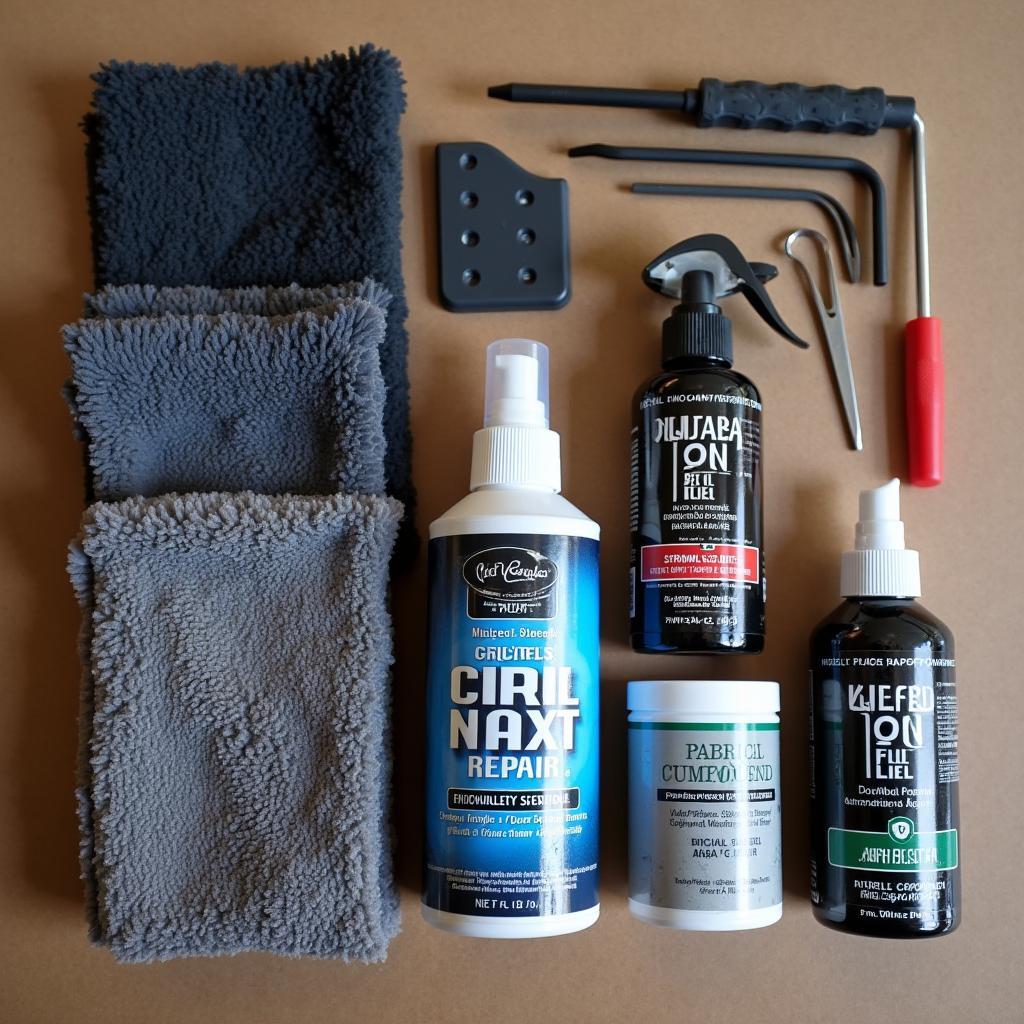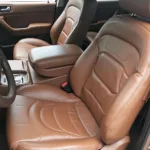A burn hole in your black car seat can be an eyesore, but it doesn’t always mean a costly trip to the auto upholsterer. With a few simple techniques and the right materials, you can often repair minor burn holes yourself and restore your car’s interior to its former glory.
Assessing the Damage: What Kind of Burn Hole Is It?
Before you begin the repair, it’s crucial to assess the extent of the damage. A small burn mark might only require a surface treatment, while a deeper hole will need a more involved approach.
- Light Scorch Marks: These appear as discolored areas on the surface of the seat fabric. They haven’t penetrated deeply and can often be treated with cleaning and color restoration.
- Melted Fabric: This type of damage involves the actual melting of the fabric fibers. You’ll see a noticeable indentation or hole where the fabric has melted away.
Gathering Your Supplies: What You’ll Need for the Repair
Having the right tools and materials on hand will make the repair process much smoother. Here’s what you’ll need:
- Cleaning Solution: A mild upholstery cleaner or a mixture of warm water and gentle soap.
- Microfiber Cloth: For cleaning and applying solutions.
- Matching Fabric Dye: Choose a dye specifically designed for car upholstery and in a shade that matches your seat color as closely as possible.
- Filler Compound (if needed): A flexible filler compound designed for vinyl or leather repair will help fill deeper holes.
- Applicator Tools: Small brushes, cotton swabs, or a palette knife can be helpful for applying dyes and fillers.
- Hair Dryer (optional): Can be used to speed up the drying process of dyes and fillers.
Repairing the Burn Hole: Step-by-Step Guide
Now, let’s dive into the repair process:
Step 1: Clean the Area
Begin by thoroughly cleaning the affected area and the surrounding fabric with your chosen cleaning solution. This removes dirt, debris, and any loose fibers around the burn hole. Use a clean microfiber cloth and allow the area to dry completely.
Step 2: Address the Hole (If Applicable)
If you’re dealing with a hole that goes through the fabric, you’ll need to fill it before applying any dye.
- Apply a small amount of flexible filler compound to the hole, using a palette knife or your fingertip to press it in gently.
- Remove any excess filler and try to create a smooth, even surface.
- Allow the filler to dry completely according to the manufacturer’s instructions. You can use a hairdryer on a low setting to speed up the drying process if needed.
Step 3: Apply the Fabric Dye
Once the area is clean and dry (and the filler is completely set, if used), you can start applying the fabric dye.
- Starting from the outer edges of the burn mark or repaired hole, dab small amounts of dye onto the fabric using a cotton swab or a fine-tipped brush.
- Use a light touch and build up the color gradually to avoid creating a dark spot.
- Feather out the edges of the dye to blend it seamlessly with the surrounding fabric.
Step 4: Drying and Inspection
Allow the dye to dry completely. This may take a few hours, depending on the type of dye used. You can again use a hairdryer on a low setting to speed up the drying process.
Once dry, inspect the repair closely. If the color isn’t quite right or if you can still see the damage, you can apply additional thin layers of dye, allowing each layer to dry completely before applying the next.
Step 5: Protect Your Work (Optional)
For added durability and protection, consider applying a fabric protectant spray to the repaired area once the dye is fully dry. This can help prevent future stains and fading.
Preventing Future Burn Holes
While repairs can be effective, prevention is always the best approach. Here are some tips to keep your car seats looking their best:
- Be Mindful of Cigarettes: This seems obvious, but it’s the most common culprit for car seat burns. If you or your passengers smoke, use the ashtray and exercise extreme caution.
- Beware of Hot Objects: Be careful when placing hot food, drinks, or styling tools inside your car. A stray ember from a cigarette or a hot curling iron can easily cause damage.
- Use Seat Covers: Consider using seat covers, especially if you frequently transport children, pets, or cargo that could potentially damage your seats.
Seeking Professional Help
For extensive burns or damage to delicate materials like leather, it’s best to consult a professional auto upholsterer. They have the experience, tools, and expertise to handle more complex repairs and restore your car seats to pristine condition.
Remember, a burn hole in your car seat doesn’t have to be a permanent blemish. With a little effort and the right approach, you can often repair the damage yourself and keep your car’s interior looking its best.
FAQs: Addressing Common Questions about Car Seat Burn Hole Repair
Q1: Can I use superglue to fix a burn hole in my car seat?
A: While it might be tempting, using superglue is not recommended. Superglue is inflexible and can crack or peel over time, especially with the constant movement and pressure on car seats. It’s best to use a flexible filler compound specifically designed for vinyl or leather repair.
Q2: What type of fabric dye is best for car seat repair?
A: Look for a fabric dye that is specifically designed for car upholstery. These dyes are typically more durable and colorfast, meaning they are less likely to fade or rub off over time. Choose a dye that closely matches the color of your car seat for the best results.
Q3: I spilled bleach on my black car seat and it left a discolored spot. Can I fix this?
A: Unfortunately, bleach damage is often permanent, as it removes the color from the fabric rather than simply staining it. You might be able to disguise the damage by applying black fabric dye to the affected area, but a professional upholstery repair might be necessary for a more permanent solution.
Q4: My car seat has a small tear near the burn hole. Can I repair both issues at the same time?
A: Yes, you can address both the burn hole and the tear using similar techniques. You can use a flexible filler compound to fill the hole and secure the edges of the tear. Once the filler is dry, you can apply fabric dye to blend the repair with the surrounding fabric. If you’re unsure about repairing a tear, especially a larger one, it’s always a good idea to consult a professional.
Q5: How long does it take for the fabric dye to dry completely?
A: Drying times can vary depending on the type of fabric dye used, the ambient temperature, and humidity. In general, it’s best to allow the dye to dry for at least a few hours or as directed on the product’s instructions. Using a hairdryer on a low setting can help speed up the drying process.
Explore More Car Seat Repair Tips
Looking for more helpful advice on car seat repair? Check out these articles:
- How to Repair Torn Car Seat Fabric
- Black Leather Car Seat Repair
- How to Repair Cigarette Burn in Vinyl Car Seat
Don’t let a burn hole ruin the look of your car’s interior. With a few simple steps, you can often repair the damage yourself and restore your seats to their former glory. Remember, prevention is key, so be mindful of hot objects and use caution when smoking in your car. If you’re ever unsure about a repair, don’t hesitate to seek professional help.
For personalized guidance and expert advice on your car repair needs, get in touch with us! Our dedicated team at CarRepairOnline is available 24/7 to assist you. Reach us via WhatsApp at +1(641)206-8880 or email us at [email protected]. Let us help you get back on the road with confidence.



